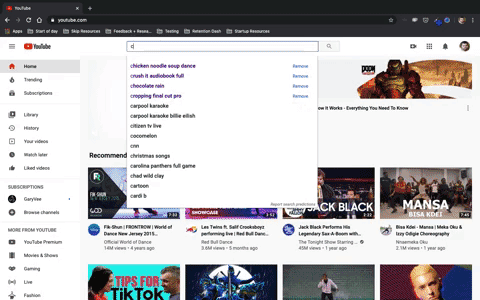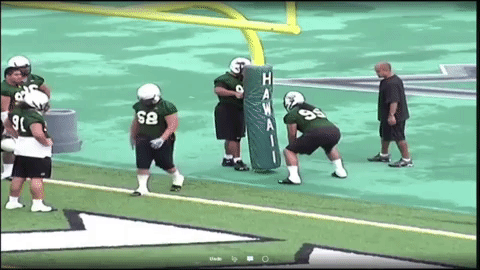Fundamental D-Line Skills
Hello and welcome to another edition of the D-Line Examples newsletter. My name is Craig, and each week I humbly tackle reader questions about how to coach and play defensive line. If you have any questions DM me on my Twitter and in return, I’ll offer actionable real-world advice.
Q: Hi Craig. I’m a youth assistant coach (ages 6-18) and I was wondering what basic principles and techniques would you feel are most important to set a good foundation for athletes at this level?
Before NFL greats like Aaron Donald and JJ Watt were paid millions to dominate opposing offensive lines, they first had to learn the fundamentals of D-Line. And I know for a fact they weren’t working on intercepting passes in their pop warner days.
Joking aside, improving fundamental skills for young athletes is absolutely critical to developing them into great D-Linemen. So, let’s talk what areas you should be focussing on.
The 3 fundamental skills
The 3 core fundamentals young D-Linemen should be developing are stance, get off and hands. These fundamentals set the foundation for dominant and successful D-Line play. I’ll explain…
Stance
First, stance is the foundation from which all post snap movement comes from. If your stance isn’t on point then every movement after will suffer.
Get off
Second, get off is how a D-Lineman generate power from their stance. For all us physics nerds out there we know that force = mass x acceleration. So, when you explode out of your stance before your opponent has even flinched you give yourself the ability to maximize your acceleration and thus amplifying your force.
Hands
Lastly, your hands are the pathway in which all the power you’ve generated from your stance and get off is transferred into your opponent. When hands are placed on your opponent with proper position and violence the result is devastating.
Combined these three fundamentals skills give any D-Lineman the base level skill to dominate their opponent.
Improving stance
As I said above, stance is the foundation from which all post snap movement comes from, but there are so many stances to choose from. Should you use a 2, 3 or 4 point stance? Should the inside foot or outside foot be back? What about frog stance? Shouldn’t you use that in a 3-4?
These are all great questions and ones that should be answered, but not today. That’s because the only stance you should be practicing with a young D-Lineman is a 3-point. In my experience over my 20+ years playing football the #1 stance used in all defenses is the 3-point stance with your man hand down and man foot back.
If I’m the coach, this is the first stance I’m teaching any young D-Lineman. The reason being is that every kid can get into it (ages 6 - 18), every defense uses this stance and it keeps your pad level low.
So how exactly should you teach the 3-point?
Thankfully, one of the best D-Line coaches out there Coach Rolle has made what I think is the definitive resource on how to teach 3 point stance on his youtube channel. To check out part 1 click here and for part 2 click here. Trust me you want to watch these.
Now that your D-Line knows how to get into stance, they need to build their ability to feel comfortable in it. To do this use stance holds (shown below).
With stance holds have your D-Line hold their stance for 10-20 seconds and then take 2 hard steps when they feel they’re about to fail. Repeat this for 5 reps on each side.
Great thing about this drill too is that you can practice it anywhere. I remember in my pop warner days getting into a 3-point right before bed so I could improve how long I could hold my stance comfortably. Good times!
Improving get off
It just so happens I’ve already written a post with 4 drills on how to improve get off that you can check out here and 3 of the 4 drills I mentioned can be used for any age.
And just in case you don’t like clicking links, I’ve included below the 3 drills I’d recommend for improving get off.
Drill #1: Ball reaction drill
All you need for this one is a ball and a friend. Practice your get off by keying the ball and grabbing as much green grass as you can with your first step when the ball twitches.
Drill #2: Youtube visualization drill
Coronavirus can't stop this drill. Just type in CFB full games into Youtube, select the first game you see and visualize yourself getting off the ball when the ball is snapped in the youtube clip.
It doesn't seem like much, but visualization is one of the most powerful tools you can utilize to improve your get off.
Drill #3: Reaction time test
There are a ton of reaction apps and games that you can play on your computer or phone. One that I like is the reaction time test (seen below). Play games like these as much as possible. Getting as many reps as possible to train your reaction is absolutely necessary!
Improving hands
When improving hands it’s best to separate your drill work into two buckets…
Hand violence in the run
Hand violence while pass rushing
Usage of hands in these two instances is a bit different so it requires different sets of drill work.
First, for hand violence in the run, I’d start with goal post strikes. This teaches young defensive linemen to strike violently with two points of contact.
Then, once your D-Line starts getting the hang of striking with violence, work in the push and press drill so your D-Line not only understands how to strike, but also how to extend, keep pressure while locating the ball and escaping.
Conversely, while pass rushing you need to teach your D-Line to violently swat the blockers hands away.
A great drill for this is the hand block drill. It’s a simple drill that doesn’t require much instruction other than to violently smack away the blockers hand before it hits your chest.
This drill will teach your D-Line to be violent with their hand and set the foundation for being able to teach coordinating hands and hips while pass rushing.
A final word
To sum everything up, improving stance, get off and hands will give your D-Line the foundation they need to defeat their opponents and progress to more advanced techniques like flipping the hips, escaping and executing pass rush moves.
Fundamentals though aren’t something you practice once and never work on again. Fundamentals should be worked every day.
As the great Pete Jenkins said, “You need to find a way to work your fundamentals every single day.”
That’s all for this week folks! See ya next week.
And whenever you are ready, there are 2 ways I can help you:
Learn how to develop top tier pass rushers and a lethal pass rush attack here (1,000+ students)
Learn how to turn your D-Line into a block destruction machine here (1,100+ students)
-Craig








